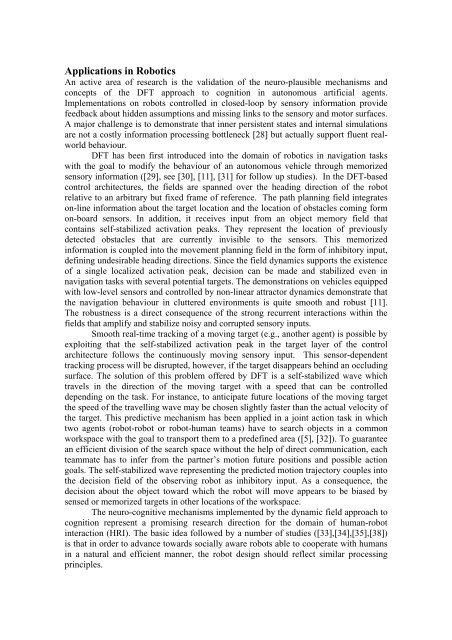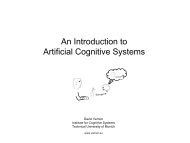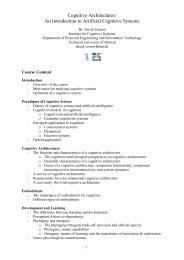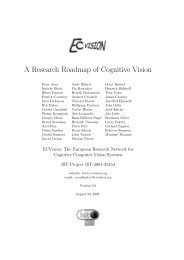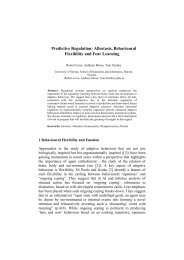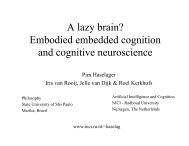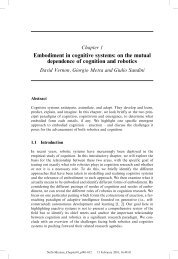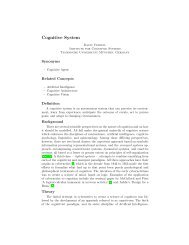Dynamic Field Theory (DFT): Applications in Cognitive Science and ...
Dynamic Field Theory (DFT): Applications in Cognitive Science and ...
Dynamic Field Theory (DFT): Applications in Cognitive Science and ...
Create successful ePaper yourself
Turn your PDF publications into a flip-book with our unique Google optimized e-Paper software.
<strong>Applications</strong> <strong>in</strong> Robotics<br />
An active area of research is the validation of the neuro-plausible mechanisms <strong>and</strong><br />
concepts of the <strong>DFT</strong> approach to cognition <strong>in</strong> autonomous artificial agents.<br />
Implementations on robots controlled <strong>in</strong> closed-loop by sensory <strong>in</strong>formation provide<br />
feedback about hidden assumptions <strong>and</strong> miss<strong>in</strong>g l<strong>in</strong>ks to the sensory <strong>and</strong> motor surfaces.<br />
A major challenge is to demonstrate that <strong>in</strong>ner persistent states <strong>and</strong> <strong>in</strong>ternal simulations<br />
are not a costly <strong>in</strong>formation process<strong>in</strong>g bottleneck [28] but actually support fluent realworld<br />
behaviour.<br />
<strong>DFT</strong> has been first <strong>in</strong>troduced <strong>in</strong>to the doma<strong>in</strong> of robotics <strong>in</strong> navigation tasks<br />
with the goal to modify the behaviour of an autonomous vehicle through memorized<br />
sensory <strong>in</strong>formation ([29], see [30], [11], [31] for follow up studies). In the <strong>DFT</strong>-based<br />
control architectures, the fields are spanned over the head<strong>in</strong>g direction of the robot<br />
relative to an arbitrary but fixed frame of reference. The path plann<strong>in</strong>g field <strong>in</strong>tegrates<br />
on-l<strong>in</strong>e <strong>in</strong>formation about the target location <strong>and</strong> the location of obstacles com<strong>in</strong>g form<br />
on-board sensors. In addition, it receives <strong>in</strong>put from an object memory field that<br />
conta<strong>in</strong>s self-stabilized activation peaks. They represent the location of previously<br />
detected obstacles that are currently <strong>in</strong>visible to the sensors. This memorized<br />
<strong>in</strong>formation is coupled <strong>in</strong>to the movement plann<strong>in</strong>g field <strong>in</strong> the form of <strong>in</strong>hibitory <strong>in</strong>put,<br />
def<strong>in</strong><strong>in</strong>g undesirable head<strong>in</strong>g directions. S<strong>in</strong>ce the field dynamics supports the existence<br />
of a s<strong>in</strong>gle localized activation peak, decision can be made <strong>and</strong> stabilized even <strong>in</strong><br />
navigation tasks with several potential targets. The demonstrations on vehicles equipped<br />
with low-level sensors <strong>and</strong> controlled by non-l<strong>in</strong>ear attractor dynamics demonstrate that<br />
the navigation behaviour <strong>in</strong> cluttered environments is quite smooth <strong>and</strong> robust [11].<br />
The robustness is a direct consequence of the strong recurrent <strong>in</strong>teractions with<strong>in</strong> the<br />
fields that amplify <strong>and</strong> stabilize noisy <strong>and</strong> corrupted sensory <strong>in</strong>puts.<br />
Smooth real-time track<strong>in</strong>g of a mov<strong>in</strong>g target (e.g., another agent) is possible by<br />
exploit<strong>in</strong>g that the self-stabilized activation peak <strong>in</strong> the target layer of the control<br />
architecture follows the cont<strong>in</strong>uously mov<strong>in</strong>g sensory <strong>in</strong>put. This sensor-dependent<br />
track<strong>in</strong>g process will be disrupted, however, if the target disappears beh<strong>in</strong>d an occlud<strong>in</strong>g<br />
surface. The solution of this problem offered by <strong>DFT</strong> is a self-stabilized wave which<br />
travels <strong>in</strong> the direction of the mov<strong>in</strong>g target with a speed that can be controlled<br />
depend<strong>in</strong>g on the task. For <strong>in</strong>stance, to anticipate future locations of the mov<strong>in</strong>g target<br />
the speed of the travell<strong>in</strong>g wave may be chosen slightly faster than the actual velocity of<br />
the target. This predictive mechanism has been applied <strong>in</strong> a jo<strong>in</strong>t action task <strong>in</strong> which<br />
two agents (robot-robot or robot-human teams) have to search objects <strong>in</strong> a common<br />
workspace with the goal to transport them to a predef<strong>in</strong>ed area ([5], [32]). To guarantee<br />
an efficient division of the search space without the help of direct communication, each<br />
teammate has to <strong>in</strong>fer from the partner’s motion future positions <strong>and</strong> possible action<br />
goals. The self-stabilized wave represent<strong>in</strong>g the predicted motion trajectory couples <strong>in</strong>to<br />
the decision field of the observ<strong>in</strong>g robot as <strong>in</strong>hibitory <strong>in</strong>put. As a consequence, the<br />
decision about the object toward which the robot will move appears to be biased by<br />
sensed or memorized targets <strong>in</strong> other locations of the workspace.<br />
The neuro-cognitive mechanisms implemented by the dynamic field approach to<br />
cognition represent a promis<strong>in</strong>g research direction for the doma<strong>in</strong> of human-robot<br />
<strong>in</strong>teraction (HRI). The basic idea followed by a number of studies ([33],[34],[35],[38])<br />
is that <strong>in</strong> order to advance towards socially aware robots able to cooperate with humans<br />
<strong>in</strong> a natural <strong>and</strong> efficient manner, the robot design should reflect similar process<strong>in</strong>g<br />
pr<strong>in</strong>ciples.


